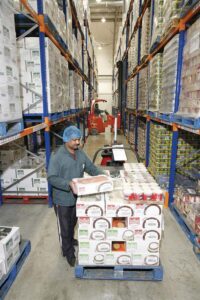 Warehouse and distribution centre bosses face constant pressure to maximise use of storage space. But creating extra pallet locations counts for little if cutting aisle widths means sacrificing forklift travel speeds and efficient throughputs.
Warehouse and distribution centre bosses face constant pressure to maximise use of storage space. But creating extra pallet locations counts for little if cutting aisle widths means sacrificing forklift travel speeds and efficient throughputs.
That’s the message from John Maguire, Sales and Marketing Director of Narrow Aisle Flexi, whose G4 electric VNA counterbalance truck is Europe’s most popular articulated forklift.
Traditionally, John points out, the narrowest aisle widths were achieved using Very Narrow Aisle forklifts. Depending on load sizes VNA machines can work in aisles just 1.4 metres wide because they turn only the load, while other forklifts turn the entire vehicle.
The early 1990s arrival of the articulated truck, which also turns only the load in the aisleway, gave specifiers a forklift able both to work in narrow aisles and load and unload lorries.
“When articulated forklifts were first introduced they were offered as an effective alternative to VNA trucks,” says John Maguire. “But we believe modern warehouse designers and some forklift truck manufacturers now place too much emphasis on achieving the narrowest aisleways and, as a result, safety and productivity can be compromised.
“Although I’d be the first to acknowledge that the accepted wisdom about restricting aisle widths has benefited articulated forklift truck sales, narrowing aisles has become an obsession,” John continues. “Companies like ours must take some responsibility; after all we’ve been stressing the benefits of minimising aisle widths for years.
“In attempting to squeeze the highest number of racking runs into any given storage cube, many companies put their forklift fleet’s efficiency and productivity at risk.
“Narrowing aisleways restricts forklifts’ travelling speed between picking locations. It might be technically feasible for articulated forklift trucks to pick up and turn pallets in aisles as narrow as 1.8m, but where high throughputs need to be achieved, faster travel speeds are required, which calls for sufficient aisleway clearance.
“I recently visited a site where the articulated trucks had to travel at below half their top speed within the aisles because the aisle widths were so narrow there was little margin for error on either side. This is clearly counter productive to any benefits from being able to add extra pallet positions by cutting the aisle dimensions.”
Some years ago the British Industrial Truck Association (Bita) introduced Guidance Note 9 (GN9), allowing minimum aisle widths to be determined based on the type and combination of fork trucks being used.
John Maguire continues: “The regulation width for reach truck aisles is 2.7m, but no-one would design a storage system around 2.7m wide aisles because trucks would be forced to operate too slowly. That’s why most aisles where reach trucks operate, including most major supermarket RDCs, tend to be 3 or 3.1m wide.
“Even going to 2m wide aisles, articulated trucks are still far more space-efficient than reach trucks. Articulated trucks are also faster than reach trucks, and remove the need for double handling inside and outside.
“These are all reasons why articulated trucks have, and continue to have, a significant impact on reach truck sales and are recognised as a highly credible alternative to reach trucks in more and more applications.
“Narrow Aisle is winning business by supplying solutions that allow maximum storage density as well as fast throughputs to be achieved. Our message is that creating extra storage space is important, but accounts for little if it means having to sacrifice truck travel speeds and efficient throughput.”
Narrow Aisle
John Maguire, Director,
Sales and Marketing,
Tel: 0121 557 6242
Email: info@flexi.co.uk




Comments are closed.